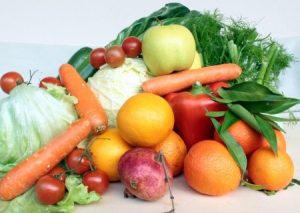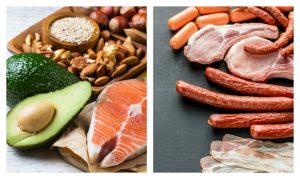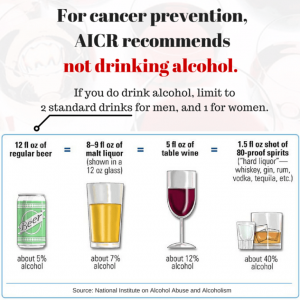As Breast Cancer Awareness month draws to a close, must we put away the pink ribbons as we start preparing our red ribbons to “Go Red” for heart health? Or what would it look like to “Go Pink AND Red” all year long? I touched on this while addressing fellow registered dietitian nutritionists at our premier national educational conference. I presented on translating the AICR recommendations for reducing cancer risk in the context of overall health. I am passionately committed to sharing the message that a healthful lifestyle will mean reducing risk of cancer AND risk of heart disease, so I was both thrilled and honored at this opportunity.
Here are some examples illustrating ways we can “Go Pink AND Red”.
Several choices are consistent in recommendations to reduce risk of both breast cancer and heart disease:
Weave physical activity into your day. We need to retrain our self-talk on this and stop seeing it as some sort of punishment for unhealthy eating or weight. Over time, physical activity does help maintain a healthy weight. In doing that, it can indirectly support prevention of breast cancer and heart disease. But regular physical activity also has direct effects on insulin, estrogen and inflammation that can reduce risk of both diseases.
- Look for a spot when you are sitting waiting for someone or something, walk as you wait.
- Set a timer to cut short 15 minutes of surfing channels or the web; instead, take a walk or turn on your favorite tunes and have fun moving to the music.
- Meet a friend for a walk or dance class instead of a drink or a movie.

- Boost fruit and vegetable portions and colors. Dark green leafy vegetables protect blood pressure with potassium, magnesium and plant compounds called polyphenols. Moreover, dark green and deep orange fruits and veggies provide beta-carotene that brings antioxidant protection, as do vitamin C-rich choices (such as bell peppers, cauliflower, kiwi and oranges). Limited evidence also links foods high in the family of carotenoids with lower risk of breast cancer.
- Start by including some sort of fruit or vegetable in each meal.
- See how much variety you can include over each week.
- Think beyond side dishes, experiment with adding vegetables to mixed dishes and fruits to a salad.
Stop the gain. Most adults gain small amounts of weight each year. One year at a time it may not be much, but it adds up. The all-too-common yearly loss of muscle can mask how much of that weight gain is from body fat. Among women after menopause, increased body fat can cause increased levels of estrogen, an established risk factor for breast cancer. Excess body fat, especially around the waist, can also lead to chronic, low-grade inflammation that promotes development of both heart disease and cancer.
Modest weight loss of 5% to 10% can reduce risk of heart disease, likely through improving blood pressure, inflammation and insulin resistance. Reduction of these markers of risk means potential for breast cancer protection with weight loss which might be as little as 7 to 15 pounds. Although we don’t yet have research that clearly shows reduced breast cancer risk with weight loss, convincing evidence links adult weight gain with greater risk of postmenopausal breast cancer.
So even if you’re not up for targeting weight loss, choosing a few habit swaps to stop or slow weight gain is clearly a good move.
- Forget super-restrictive diets and forbidden foods that set you up for binges and cycles of weight loss and regain.
- Look for some simple shifts: cut portions of foods other than vegetables; rethink how often you have sugar-loaded soft drinks, sweet tea and “deluxe” coffees; find non-food ways to comfort or reward yourself, saving “treat” foods for occasions when you will stop and savor them.
Some recommendations more specifically target reducing risk of breast cancer or heart disease, so look for the common ground.

Dietary fats come in many forms.
Cut saturated fat with smart swaps. Reducing saturated fat can help heart health, but not if it’s exchanged for fat-free foods high in added sugars or refined grains. Make the cut smart by replacing fatty meat and rich bakery items with foods higher in unsaturated fat, plant protein and whole grains (with fiber that can lower LDL cholesterol or feed healthful gut microbes). Although cutting saturated fat doesn’t necessarily provide breast cancer protection, limiting ultra-processed foods high in calories from added sugars and fats is shown to help maintain a healthy weight, which is among the strongest steps for reducing risk of breast cancer after menopause.
- Boost unsaturated fat with more frequent fish and poultry, in addition to choosing leaner meat. And keep a healthy variety of protein sources by swapping foods like bacon and sausage for avocadoes, nuts, seeds and olives in salads and sandwiches and as snacks.
- Expand plant protein by swapping beans or lentils for meat in chili, tacos and stews.
- Skip the fat-free cookies and muffins. Snack on nuts, fruit, or veggies with hummus.

Think limbo for alcohol: how low can you go? Alcohol is convincingly linked with risk of both pre- and post-menopausal breast cancer. It results in carcinogen exposure and tends to raise body estrogen levels. Although many people think of alcohol as heart-healthy, amounts beyond moderation can raise heart risks due to increases in blood pressure and blood triglycerides, as well as promoting weight gain. For lowest breast cancer risk, no alcohol is best; if you want to drink, women should make it one a day at most.
- Focus on amount, not type. Alcohol’s link to breast cancer is consistent, regardless of whether it’s beer, distilled liquor (like vodka or gin), white wine or red wine.
- Start with times when you drink alcohol that would be easiest to change. Create a habit of unwinding with yoga, a walk, or an audio book, for example. Switch some of your socializing to meeting for coffee or activities.
The elephant in the room: Avoid tobacco.
Period. Tobacco is a major risk for heart disease. And though it’s not linked to breast cancer, it’s so strongly linked with other cancers, we can’t talk about reducing cancer risk without emphasizing its importance.
If you are among those who have been hanging on to smoking as a way to control weight, there are better ways. What you eat, what you drink, how much you move, and how much you sit all offer ways to avoid weight gain using choices that are actually pro-health instead of health threats. And if you are among those who gain a few pounds, the net health benefits of quitting far outweigh them.






Thanks for your nutrition blog. I have probably had more vegetables in the last ten years than in the previous 64 years. A doughnut a day is still a big pleasure and habit I can not pass up. Bob Ungerer